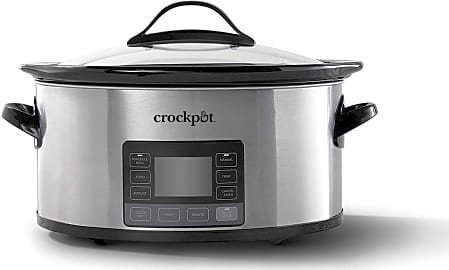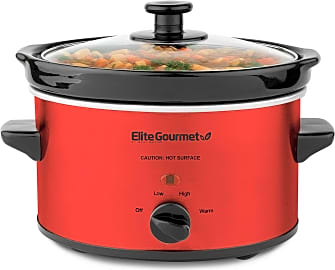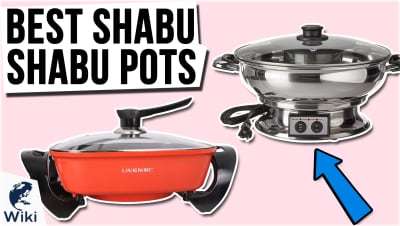The 8 Best Crockpots

This wiki has been updated 39 times since it was first published in May of 2015. A Crock-Pot comes in handy when you’re preparing a big family meal and don’t want to slave over a hot stove for hours, or if you simply enjoy the flavors of soups, stews, and roasts that have been cooking slowly all day long. Our selection features budget-friendly, manually controlled choices, as well as ones that are conveniently programmable with the touch of a few buttons. When users buy our independently chosen editorial selections, we may earn commissions to help fund the Wiki.
Editor's Notes
June 18, 2021:
We've removed models from Ninja and Hamilton Beach that are now extremely hard to find. We've also upgraded to the Crock-Pot MyTime, one of the more affordable digital models on the market. We continue to find the Instant Pot Duo Nova one of the best on the market. In particular, the 10-quart model is about as versatile a multi-cooker as any. Alternatively, the Hamilton Beach Set & Forget is another powerful digital option that costs notably less than the most advanced Instant Pot. You'll also notice some original models here like the Crock-Pot MyTime and Crock-Pot SCR503SP. It's not a surprise that the company after which an entire category of appliances is named still makes great options.
January 13, 2020:
Several programmable slow cooker models come on board today to replace either outdated versions or, in one stance, a Wi-Fi-equipped model that is known for not staying reliably connected (the WeMo Smart). The Crock-Pot 6.5-Quart Programmable features a generous capacity, and has a touchscreen panel that allows you to program your desired heat level and cook time in a matter of seconds. It boasts a sleek, shiny exterior and handles that stay safely cool to the touch, thanks to their silicone wrapping. Although it’s not new to the list, another programmable model that’s worth a mention is the Instant Pot Duo60, a best-seller that’s not just a slow cooker, as it also serves as a pressure cooker, a sauté pan, a food warmer, and a maker of rice and yogurt. For busy families who want all of these capabilities in one convenient package, this may be the way to go.
If you’re in search of a no-frills, non-programmable model, look to the Crock-Pot 8-Quart Oval Manual, an extra-large choice that can help you feed up to 10 family members or guests. The removable stoneware and glass lid are both dishwasher safe. Note that if you want to take your slow cooker full of food to parties, this won’t be the best choice for you, as it does not have a locking lid. For a non-programmable model that has a three-in-one design, look to the newly added Maxi-Matic Elite Platinum Triple, which is great for buffet-style get togethers, as each of the three 2.5-quart ceramic pots has a separate, adjustable temperature control. The convenient lid rests help unburden your guests from having to hold a lid (or figure out what to do with it) while they serve themselves.
Although slow cookers are usually operating for many hours at a time, they’re generally extremely safe to use, you’ll be happy to know. Some fans of the popular fictional NBC show “This Is Us” became nervous in 2018 when Jack Person’s death was caused by a slow cooker with a faulty switch. They questioned whether this could happen when they used their own slow cookers. The panic prompted the Crock-Pot brand to come up with a special Twitter account to allay unfounded fears, and they incorporated the hashtag #CrockPotisInnocent. In the real world, the chances of one of these devices causing a fire are extremely rare, since they run on low currents of 300 watts or less. That being said, always practice slow cooker safety by keeping and storing yours on a flat, stable surface and unplugging it when it’s not in use. If your slow cooker gets warm or hot on the outside during use, be sure to keep it away from children or pets.
Special Honors
Open Kitchen Programmable Slow Cooker This large-capacity model, available exclusively from Williams Sonoma, has enough room for meals that serve 6 to 7 people. Its large LCD is conveniently legible from across the kitchen, and it offers a countdown timer that can be set for anywhere from 30 minutes to 20 hours. The removable stoneware pot is ideal for serving at the table once the food is ready. Three temperature control settings give you the flexibility to cook your food over a timeframe that’s convenient for you. williams-sonoma.com
Crockpots Versus Slow-Cookers: Why The Confusion?
This may be a better option for some, but they commonly require more babysitting than Crockpots to prevent burning and scorching.
Both Crockpots and slow-cookers run on electric power, and typically feature three standard parts–a ceramic base insert, a glass lid, and a heating element–, but they are not one in the same. You see, all Crockpots are slow-cookers, but not all slow-cookers are Crockpots. Actually, the term Crockpot is a brand name, like Band-Aids are to bandages.
The number one difference between the two boils down, pun intended, to heat distribution. Slow-cookers generally have one heating element running along the base of the unit, whereas Crockpots have multiple heating elements on the bottom and the sides.
This may not seem like a huge difference, but when it comes to slow-cooking larger cuts of meat, Crockpots are the clear winner, as they evenly distribute heat all around the meat, lessening the chance of improperly cooked meals that may lead to food-borne illnesses.
Though slow-cookers lack additional heating elements, they offer a broader range of temperatures at which to cook. This may be a better option for some, but they commonly require more babysitting than Crockpots to prevent burning and scorching.
The Science Behind Crockpots
Why do people like tender meat so much? Why does it taste so much better when it's "falling off the bone"?
We cannot actually answer those questions, but our guess is it has to do with the fat meat contains; since our bodies and brains are wired to consume fat to create energy. Not to mention its great for skin and hair health. Besides, it just tastes so darn delicious.
Which brings us to our next question: What makes meat so juicy and tender?
Believe it or not, there's an actual science behind slow-cooking meats.
This is where temperature and length of cooking time make all the difference.
Some crockpot enthusiasts swear up and down that searing meat before placing it into the crockpot will either make, or break your meal. This step isn't necessary, but absolutely worth the effort. Why is that?
Searing meat at a high temperature, a technique called browning, aka the Maillard reaction, caramelizes the surface of the meat, creating all those phenomenal flavors we know and love; not to mention, this step also kills bacteria. But like we said, this isn't necessary, if you're into boring foods.
What does this all have to do with crockpots? This is where the science comes in.
At 160-degrees, collagen within the meat begins to breakdown, which may sound disgusting but it's actually building even more flavors. This is referred to as a kinetic process, or rate of reaction in a chemical process. This is where temperature and length of cooking time make all the difference.
In order to liquify the collagen, the duration of cooking has to be increased, while the cooking temperature needs to be decreased. Not only that, but the steam created and captured within the crockpot is continuously adding moisture to the meat, greatly reducing its risk of drying out.
Now you understand why they're also called slow-cookers?
Furthermore, crockpots are huge time savers. In a world where everyone always seems so busy with life's responsibilities, though we've had it easy when compared to our ancestors, crockpots are an economical way to make sure there's food on the table.
Our last question: What's not to love about them?!
The Slow-Cooked History of the Crock-Pot
The first crockpots introduced to consumers were produced solely for the sake of making beans, hence their first name: the Naxon Beanery All-Purpose Cooker. This was in 1936.
All the credit goes to Chicagoan, Irving Naxon, leading the Naxon Utilities Corporation. This guy was a pretty big deal in his time; some say he invented a precursor to the modern fax machine we still use today.
The two ideas finally came hand in hand, and the market had to catch up with demands.
In 1970, the Rival Company bought Irving out, and put these devices on the market one year later, under the Crock-Pot name. Rival also published several crockpot cookbooks, but it was the inspiring author of Mable Hoffman's "Crockery Cookery" in 1975 who got the ball rolling with crockpot cooking.
It also helped that by this time in the mid-1970s, more women were leaving households to work than ever before. The two ideas finally came hand in hand, and the market had to catch up with demands.
Since then, crockpot designs have changed drastically, into more efficient, high-tech devices, but the same concept still remains. Sales go through the roof in winter, when cold temperatures conjure up images of a hot, slow-cooked meal just waiting for you to sink your teeth into it.













